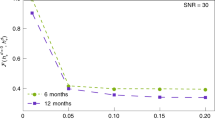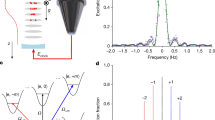Abstract
One of the central predictions of metric theories of gravity, such as general relativity, is that a clock in a gravitational potential U will run more slowly by a factor of 1 + U/c2, where c is the velocity of light, as compared to a similar clock outside the potential1. This effect, known as gravitational redshift, is important to the operation of the global positioning system2, timekeeping3,4 and future experiments with ultra-precise, space-based clocks5 (such as searches for variations in fundamental constants). The gravitational redshift has been measured using clocks on a tower6, an aircraft7 and a rocket8, currently reaching an accuracy of 7 × 10-5. Here we show that laboratory experiments based on quantum interference of atoms9,10 enable a much more precise measurement, yielding an accuracy of 7 × 10-9. Our result supports the view that gravity is a manifestation of space-time curvature, an underlying principle of general relativity that has come under scrutiny in connection with the search for a theory of quantum gravity11. Improving the redshift measurement is particularly important because this test has been the least accurate among the experiments that are required to support curved space-time theories1.
This is a preview of subscription content, access via your institution
Access options
Subscribe to this journal
Receive 51 print issues and online access
$199.00 per year
only $3.90 per issue
Buy this article
- Purchase on Springer Link
- Instant access to full article PDF
Prices may be subject to local taxes which are calculated during checkout


Similar content being viewed by others
References
Will, C. M. The confrontation between general relativity and experiment. Living Rev. Relativity 9, 3 (2006); 〈http://relativity.livingreviews.org/Articles/lrr-2006-3/〉
Ashby, N. Relativity in the global positioning system. Living Rev. Relativity 6, 1 (2003); 〈http://relativity.livingreviews.org/Articles/lrr-2003-1/〉
Rosenband, T. et al. Frequency ratio of Al+ and Hg+ single-ion optical clocks; metrology at the 17th decimal place. Science 319, 1808–1812 (2008)
Pavlis, N. K. & Weiss, M. A. The relativistic gravitational redshift with 3×10-17 uncertainty at NIST, Boulder, Colorado. Metrologia 40, 66–73 (2003)
Cacciapuoti, L. & Salomon, C. Space clocks and fundamental tests: the ACES experiment. Eur. Phys. J. Spec. Top. 127, 57–68 (2009)
Pound, R. V. & Snider, J. L. Effect of gravity on gamma radiation. Phys. Rev. 140, B788–B803 (1965)
Hafele, J. C. & Keating, R. E. Around-the-world atomic clocks: observed relativistic time gains. Science 177, 168–170 (1972)
Vessot, R. F. C. et al. Test of relativistic gravitation with a space-borne hydrogen maser. Phys. Rev. Lett. 45, 2081–2084 (1980)
Peters, A., Chung, K. Y. & Chu, S. A measurement of gravitational acceleration by dropping atoms. Nature 400, 849–852 (1999)
Peters, A., Chung, K.-Y. & Chu, S. High-precision gravity measurements using atom interferometry. Metrologia 38, 25–61 (2001)
Amelino-Camelia, G., Macias, A. & Müller, H. in Gravitation and Cosmology (eds Macias, A., Lämmerzahl, C. & Nuñez, D.) 30 (AIP Conf. Proc. 758, American Institute of Physics, 2005)
Fortier, T. M. et al. Precision atomic spectroscopy for improved limits on variation of the fine structure constant and local position invariance. Phys. Rev. Lett. 98, 070801 (2007)
Blatt, S. et al. New limits on coupling of fundamental constants to gravity using 87Sr optical lattice clocks. Phys. Rev. Lett. 100, 140801 (2008)
Kasevich, M. & Chu, S. Atomic interferometry using stimulated Raman transitions. Phys. Rev. Lett. 67, 181–184 (1991)
Bordé, C. J., Karasiewicz, A. & Tourrenc General relativistic framework for atomic interferometry. Int. J. Mod. Phys. D 3, 157–161 (1994)
Dimopoulos, S., Graham, P. W., Hogan, J. M. & Kasevich, M. A. Testing general relativity with atom interferometry. Phys. Rev. Lett. 98, 111102 (2007)
Dimopoulos, S., Graham, P. W., Hogan, J. M. & Kasevich, M. A. General relativistic effects in atom interferometry. Phys. Rev. D 78, 042003 (2008)
Misner, C. W., Thorne, K. S. & Wheeler, J. A. Gravitation (Freeman, 1970)
Feynman, R. P. & Hibbs, A. R. Quantum Mechanics and Path Integrals (McGraw-Hill, 1965)
Fitch, V. L. The discovery of charge-conjugation parity asymmetry (Nobel Lecture). Rev. Mod. Phys. 53, 367–371 (1981)
Good, M. L. K2 0 and the equivalence principle. Phys. Rev. 121, 311–313 (1961)
Ivanov, V. V. et al. Coherent delocalization of atomic wave packets in driven lattice potentials. Phys. Rev. Lett. 100, 043602 (2006)
Cladé, P. et al. A promising method for the measurement of the local acceleration of gravity using Bloch oscillations of ultracold atoms in a vertical standing wave. Europhys. Lett. 71, 730–736 (2005)
Vitushkin, L. et al. Results of the sixth international comparison of absolute gravimeters. Metrologia 39, 407–424 (2002)
Müller, H., Chiow, S.-w., Long, Q., Herrmann, S. & Chu, S. Atom interferometry with up to 24-photon-momentum-transfer beam splitters. Phys. Rev. Lett. 100, 180405 (2008)
Müller, H., Chiow, S.-w., Herrmann, S. & Chu, S. Atom interferometers with scalable enclosed area. Phys. Rev. Lett. 102, 240403 (2009)
Young, B., Kasevich, M. & Chu, S. in Atom Interferometry (ed. Berman, P.) 363–406 (Academic, 1997)
Dent Eötvös bounds on couplings of fundamental parameters to gravity. Phys. Rev. Lett. 101, 041102 (2008)
Lemoine, F. G. et al. The Development of the Joint NASA GSFC and NIMA Geopotential Model EGM96 (NASA Goddard Space Flight Center, Greenbelt, Maryland, 1998)
Fuchs, K. & Soffel, H. in Landolt-Börnstein – Group V Geophysics Vol. 2a 317–321 (Springer, 1984)
Acknowledgements
We thank F. Biraben, S.-w. Chiow, S. Herrmann, M. Hohensee, M. Kasevich, G. Tino and P. Wolf for discussions. This material is based on work supported by the National Science Foundation under grants 9320142, 0400866 and 0652332, by the Air Force Office of Scientific Research, and the Department of Energy. H.M. acknowledges support by the David and Lucile Packard Foundation and the National Institute of Standards and Technology under grant 60NANB9D9169. A.P. acknowledges support by the European Science Foundation’s EUROCORES program, the European Space Agency, and the German Space Agency DLR (grant DLR 50 WM 0346).
Author Contributions All authors made substantial contributions to this work. The manuscript was written by H.M. and S.C.
Author information
Authors and Affiliations
Corresponding author
Ethics declarations
Competing interests
The authors declare no competing financial interests.
PowerPoint slides
Rights and permissions
About this article
Cite this article
Müller, H., Peters, A. & Chu, S. A precision measurement of the gravitational redshift by the interference of matter waves. Nature 463, 926–929 (2010). https://doi.org/10.1038/nature08776
Received:
Accepted:
Issue Date:
DOI: https://doi.org/10.1038/nature08776
This article is cited by
-
Quantum reference frames for an indefinite metric
Communications Physics (2023)
-
Ultrafast visualization of an electric field under the Lorentz transformation
Nature Physics (2022)
-
Exploring the foundations of the physical universe with space tests of the equivalence principle
Experimental Astronomy (2021)
-
Spatial adiabatic passage of massive quantum particles in an optical Lieb lattice
Nature Communications (2020)
-
From super-Bloch oscillations to sudden self-trapping in Bose–Einstein condensates with inter-atomic interactions
Nonlinear Dynamics (2020)
Comments
By submitting a comment you agree to abide by our Terms and Community Guidelines. If you find something abusive or that does not comply with our terms or guidelines please flag it as inappropriate.



